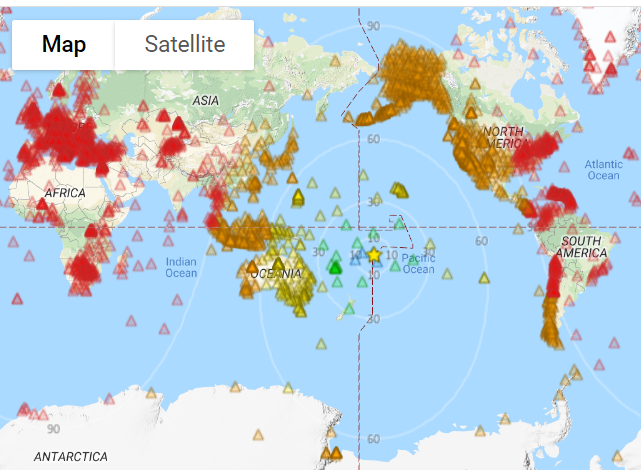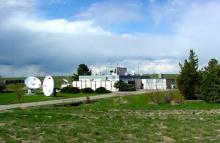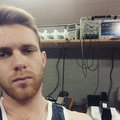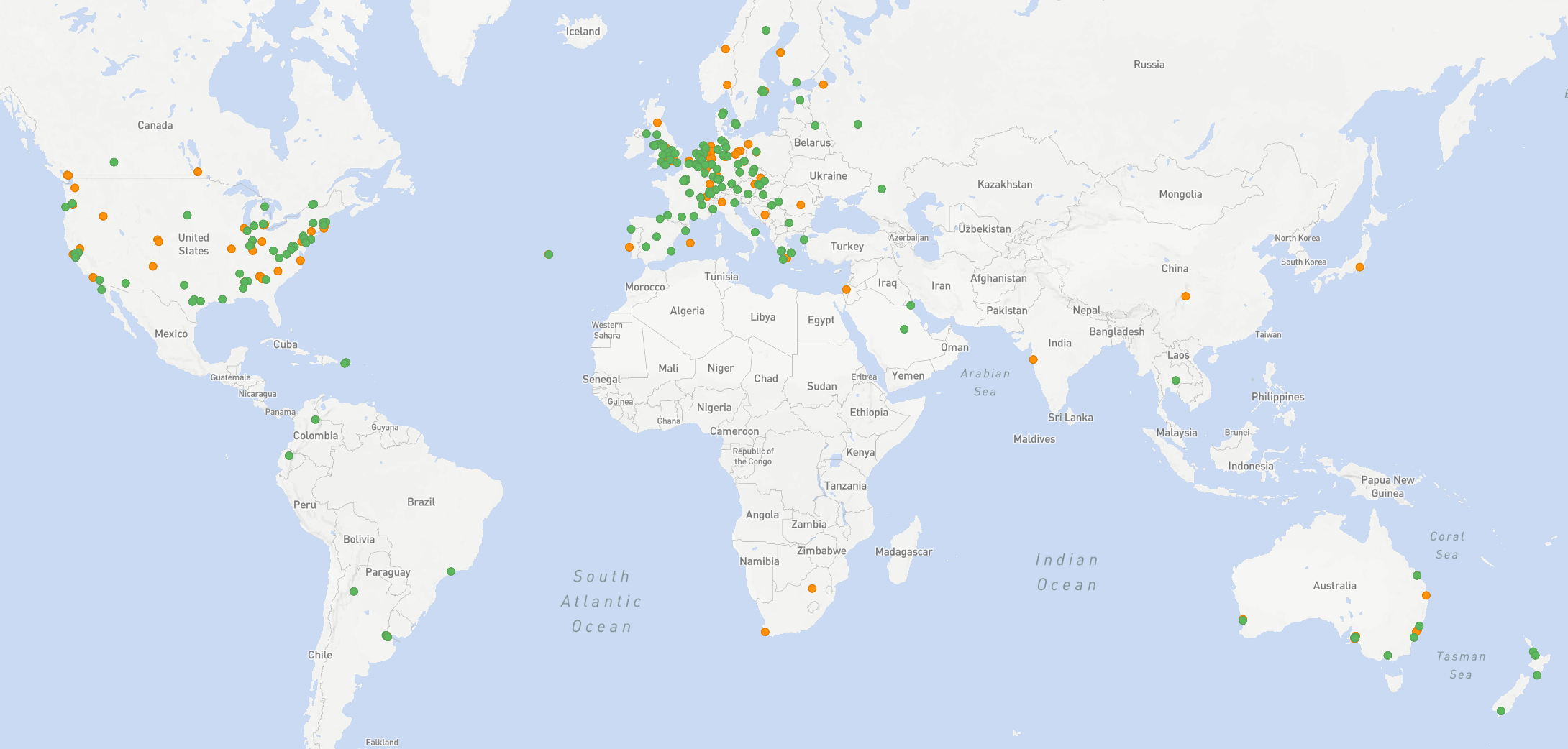-
Hack Chat Transcript, Part 2
10/30/2019 at 20:03 • 0 comments![]() @RichardCollins Indeed that would be very useful, however there are bandwidth constraints currently. However we have iqzip project https://gitlab.com/librespacefoundation/sdrmakerspace/iqzip that there are thoughts to use it in the future.
@RichardCollins Indeed that would be very useful, however there are bandwidth constraints currently. However we have iqzip project https://gitlab.com/librespacefoundation/sdrmakerspace/iqzip that there are thoughts to use it in the future.![]() @Pierros Papadeas What does it take to have one of those gracious dots on my location?
@Pierros Papadeas What does it take to have one of those gracious dots on my location?![]() This is a graph or observations per time, over the last 5 years (almost since we won the Hackaday Prize)
This is a graph or observations per time, over the last 5 years (almost since we won the Hackaday Prize)![]()
![]()
![]() that's great
that's great![]() @Taiwo https://wiki.satnogs.org/Build :) also join us on community.libre.space and feel free to ask any questions on how to get started
@Taiwo https://wiki.satnogs.org/Build :) also join us on community.libre.space and feel free to ask any questions on how to get started![]() @fredy @Pierros Papadeas I am tracking the established VLBI and radio astronomy networks, the GPS networks for geophysics and meteorolgy. The power system low frequency networks, electromagnetic interference groups, infrasound and earthquake early warning, magnetometer networks, gravimeter networks. And many more. They ALL have to subtract electromagnetic, electic field and magnetic field variations.
@fredy @Pierros Papadeas I am tracking the established VLBI and radio astronomy networks, the GPS networks for geophysics and meteorolgy. The power system low frequency networks, electromagnetic interference groups, infrasound and earthquake early warning, magnetometer networks, gravimeter networks. And many more. They ALL have to subtract electromagnetic, electic field and magnetic field variations.![]() @Taiwo generally speaking the simplest station would be an RPi4 with an rtl-sdr and a turnstile antenna
@Taiwo generally speaking the simplest station would be an RPi4 with an rtl-sdr and a turnstile antenna![]() ^^ and build up from there, add improvements over time
^^ and build up from there, add improvements over time![]() any project at Argentina?
any project at Argentina?![]() @newen we need more stations in Latin America ;)
@newen we need more stations in Latin America ;)![]() we have just a couple of ground stations there.. you can see them clicking on "map" at https://network.satnogs.org/stations/
we have just a couple of ground stations there.. you can see them clicking on "map" at https://network.satnogs.org/stations/![]() we are at center or AR
we are at center or AR![]() Having the data in human readable format is crucial. Proprietary binary formats, undocumented formats and undocumented processing steps, and proprietary software and development environments are a NO NO. All these networks can work together.
Having the data in human readable format is crucial. Proprietary binary formats, undocumented formats and undocumented processing steps, and proprietary software and development environments are a NO NO. All these networks can work together.![]() we will be launching a request for translation help in localizing our projects, which should help in places like that
we will be launching a request for translation help in localizing our projects, which should help in places like that![]() @RichardCollins absolutely!
@RichardCollins absolutely!![]() @RichardCollins couldn't agree more on the necessity of documentation and openness.
@RichardCollins couldn't agree more on the necessity of documentation and openness. For that reason we published our Libre Space Manifesto
![]()
https://wiki.satnogs.org/Build
Build
Building a ground station need not be complicated. There are a few things to consider when working out what it is you are going to do. Choices such as the desire to have a fixed or steerable ground station will play a big part in the amount of equipment needed and the time taken as well as the complexity of any build.
![]()
https://manifesto.libre.space/
Libre Space Manifesto
Space is humanity's future. It is humanity's opportunity to explore, develop, use, and thrive differently. A way to ensure the longevity, sustainability, openness, equality of those efforts for all humanity. For this, we pledge to adhere to the following: All people shall have the right to explore and use outer space for the benefit and in the interests of all humanity.
![]() <3
<3![]()
![]() Here is a recent coverage from an ISS SSTV event more details about the event can be found at https://community.libre.space/t/iss-sstv-sstv-event-to-highlight-human-spaceflight-apr-11-apr-14/3776
Here is a recent coverage from an ISS SSTV event more details about the event can be found at https://community.libre.space/t/iss-sstv-sstv-event-to-highlight-human-spaceflight-apr-11-apr-14/3776![]() This is a current map of the IRIS.edu seismometer network. They are very good at sharing data and handling things professionally. Stations include magnetotelluric and similar stations. They have standards for documentation, storage, sharing.
This is a current map of the IRIS.edu seismometer network. They are very good at sharing data and handling things professionally. Stations include magnetotelluric and similar stations. They have standards for documentation, storage, sharing.![]()
![]()
![]() Any thoughts on building a GRID so people can contribute processing resources for distributed data processing and analysis?
Any thoughts on building a GRID so people can contribute processing resources for distributed data processing and analysis?![]() So, the "data" tab (in observations) needs ascii/hex AND ax.25 to be human readable for amateur radio sats.
So, the "data" tab (in observations) needs ascii/hex AND ax.25 to be human readable for amateur radio sats.![]() I think you can do that direction. With an emphasis on even handedness across all countries. There is a gap in the global coverage of electromagnetic stations.
I think you can do that direction. With an emphasis on even handedness across all countries. There is a gap in the global coverage of electromagnetic stations.![]() @Ethan Waldo so far the computation hasn't needed it.. (most of the signals are ~9600 baud, easily handled by a rpi3 + rtlsdr).. But, may become a need for someone who wants to calculate against the telemetry sets
@Ethan Waldo so far the computation hasn't needed it.. (most of the signals are ~9600 baud, easily handled by a rpi3 + rtlsdr).. But, may become a need for someone who wants to calculate against the telemetry sets![]() @G Mallery !!!! absolutely. And complete traceability. Who did it, where it came from, what changes and corrections or filters applied, user communities, development groups, etc.
@G Mallery !!!! absolutely. And complete traceability. Who did it, where it came from, what changes and corrections or filters applied, user communities, development groups, etc.![]() @G Mallery yeah.. We've got plans to do that straight to telemetry data using the same kaitai decoders we write to get to dashboards
@G Mallery yeah.. We've got plans to do that straight to telemetry data using the same kaitai decoders we write to get to dashboards![]() @G Mallery there is an ascii/hex button, and there is an ongoing work on ax.25. However if you want to check readable data you can check the dashboard at https://dashboard.satnogs.org/
@G Mallery there is an ascii/hex button, and there is an ongoing work on ax.25. However if you want to check readable data you can check the dashboard at https://dashboard.satnogs.org/![]() for example https://dashboard.satnogs.org/d/CBwYeHSZk this is the dashboard of lightsail-2 mission from planetary society
for example https://dashboard.satnogs.org/d/CBwYeHSZk this is the dashboard of lightsail-2 mission from planetary society![]() @RichardCollins the metasat project pierros linked to earlier was formed to fill in those gaps
@RichardCollins the metasat project pierros linked to earlier was formed to fill in those gaps![]() I would not have been able to help with lightsail-2 if not for SatNOGS. Thank you
I would not have been able to help with lightsail-2 if not for SatNOGS. Thank you![]() there's traceability today, the data is all openly accessible, etc. etc. we just haven't had the resources to automate what that might look like for a user yet
there's traceability today, the data is all openly accessible, etc. etc. we just haven't had the resources to automate what that might look like for a user yet![]() @Corey Shields I guess they are just getting started and have not posted there, or they are doing their talking elsewhere. Will keep them in mind.
@Corey Shields I guess they are just getting started and have not posted there, or they are doing their talking elsewhere. Will keep them in mind.![]() it is very new, yes
it is very new, yes![]() Here we are at the one-hour mark, which is the time we usually allot in case our hosts have to get back to work. But as usual, the chat is going strong, so if you can stay on, feel free to keep going. I'll just say a hearty thanks to all the SatNOGgers for giving up time today to give us an update, and thanks to everyone for great questions and a lively discussion. I'll be posting a transcript soon in case anyone wants to refer back.
Here we are at the one-hour mark, which is the time we usually allot in case our hosts have to get back to work. But as usual, the chat is going strong, so if you can stay on, feel free to keep going. I'll just say a hearty thanks to all the SatNOGgers for giving up time today to give us an update, and thanks to everyone for great questions and a lively discussion. I'll be posting a transcript soon in case anyone wants to refer back.![]() Thanks!!
Thanks!!![]() @G Mallery :) Also interesting was the story of TBEx-A and TBEx-B that we manage to identify them and contribute to their mission by gathering data.
@G Mallery :) Also interesting was the story of TBEx-A and TBEx-B that we manage to identify them and contribute to their mission by gathering data.![]() (so new that my own involvement only dates ~2 weeks) so yeah, definite lack of docs from that front right now
(so new that my own involvement only dates ~2 weeks) so yeah, definite lack of docs from that front right now![]() Next week's Hack Chat will be Mohit Bhoite on his wonderful circuit sculptures:
Next week's Hack Chat will be Mohit Bhoite on his wonderful circuit sculptures:![]()
https://hackaday.io/event/167692-circuit-sculpture-hack-chat
![]()
![]()
-
Hack Chat Transcript, Part 1
10/30/2019 at 20:02 • 0 commentsPierros here indeed :) Also @fredy and @elkos from the core team
![]() (apart from @cshields)
(apart from @cshields)![]() OK, great - hard to keep track sometimes. Welcome all! Can we start off with a little introduction on what SatNOGS is for those who don't know?
OK, great - hard to keep track sometimes. Welcome all! Can we start off with a little introduction on what SatNOGS is for those who don't know?![]() Sure!
Sure!![]() SatNOGS is an open source stack of technologies for tracking, communicating and gathering data about satellites
SatNOGS is an open source stack of technologies for tracking, communicating and gathering data about satellites![]() Nice
Nice![]() What is the technology behind ?
What is the technology behind ?![]() That includes Ground station designs, (antennas, rotators etc), Client software, Radio software, and then on the server side many applications to orchestrate this data gathering (network, db, dashboards and others)
That includes Ground station designs, (antennas, rotators etc), Client software, Radio software, and then on the server side many applications to orchestrate this data gathering (network, db, dashboards and others)![]() So the intention is data sharing, and the hardware side is the enabler?
So the intention is data sharing, and the hardware side is the enabler?![]() What is the motivation behind ?
What is the motivation behind ?![]() with a goal of improving access to data coming from space (mostly in the ham radio bands)
with a goal of improving access to data coming from space (mostly in the ham radio bands)![]() @manaschhabra depends on the part of the stack ;) For client running the satellite observations locally it is C/GNuradio and Python, for server side it is mostly Django
@manaschhabra depends on the part of the stack ;) For client running the satellite observations locally it is C/GNuradio and Python, for server side it is mostly Django![]() how is the business sustained? like a charity?
how is the business sustained? like a charity?![]() How are users getting benefitted ?
How are users getting benefitted ?![]() And isn't it a niche area
And isn't it a niche area![]() @manaschhabra motivation is to have open data for everything space (check our foundation : Libre Space Foundation) and to promote usage of open source technologies in the space domain
@manaschhabra motivation is to have open data for everything space (check our foundation : Libre Space Foundation) and to promote usage of open source technologies in the space domain![]() Let me set a little background/context,
Let me set a little background/context,![]() Sure
Sure![]() @Hexastorm Non profit foundation behind it (Libre Space Foundation), we do have grants for development and do provide services, also winning prizes (hackaday 2014) helped kickstart this!
@Hexastorm Non profit foundation behind it (Libre Space Foundation), we do have grants for development and do provide services, also winning prizes (hackaday 2014) helped kickstart this!![]() typical satellite operators doing low-cost LEO (cubesats, etc) are often universities or research groups who may see their satellite overhead a couple of times a day. There's a lot of data they may miss out on inbetween. SatNOGS is building a global network of receivers (and the network software) to automate the collection of data for these satellites using SDR devices and raspberry pi, thus increasing the amount of data *collected* from these satellites
typical satellite operators doing low-cost LEO (cubesats, etc) are often universities or research groups who may see their satellite overhead a couple of times a day. There's a lot of data they may miss out on inbetween. SatNOGS is building a global network of receivers (and the network software) to automate the collection of data for these satellites using SDR devices and raspberry pi, thus increasing the amount of data *collected* from these satellites![]() What about from "regular" satellites - images, datasets, etc?
What about from "regular" satellites - images, datasets, etc?![]() we have hundreds of ground stations contributing now, and an automated path to go from RF to telemetry dashboards (dashboard.satnogs.org)
we have hundreds of ground stations contributing now, and an automated path to go from RF to telemetry dashboards (dashboard.satnogs.org)![]() Would you say satnogs/libre space is at production state, or "beta", or well before that?
Would you say satnogs/libre space is at production state, or "beta", or well before that?![]() Is satnogs, rx only?
Is satnogs, rx only?![]() @ted I would say in production for most Telemetry oriented usages, and alpha on other.
@ted I would say in production for most Telemetry oriented usages, and alpha on other.![]() @ted for Libre Space projects some are well in production (or proven in space) (check UPSat mission and others in https://libre.space )
@ted for Libre Space projects some are well in production (or proven in space) (check UPSat mission and others in https://libre.space )![]() @anfractuosity It's Network side yes. Locally client can TX as well. but we are trying to sort out the legal constrains around TX'ing though the Network
@anfractuosity It's Network side yes. Locally client can TX as well. but we are trying to sort out the legal constrains around TX'ing though the Network![]() gotcha cheers
gotcha cheers![]() (It is a deliverable for us for an ESA project to do TX to, so it should be solved by end of 2020 any case ;) )
(It is a deliverable for us for an ESA project to do TX to, so it should be solved by end of 2020 any case ;) )![]() ooh nice
ooh nice![]() Is Satnogs in any way associated to AWS Ground Station?
Is Satnogs in any way associated to AWS Ground Station?![]() consider it the "free tier", open source alternative ;)
consider it the "free tier", open source alternative ;)![]() @RichardCollins What do you mean by regular? NOAA, ISS METEOR etc... ?
@RichardCollins What do you mean by regular? NOAA, ISS METEOR etc... ?![]() yes
yes![]() there seems very little information on the hardware of the AWS ground station stuff
there seems very little information on the hardware of the AWS ground station stuff![]() at least that i could find
at least that i could find![]() AWS ground station is focused on their commercial partners operating in commercial frequencies today.. So, "very similar" for sure. SatNOGS is more community oriented
AWS ground station is focused on their commercial partners operating in commercial frequencies today.. So, "very similar" for sure. SatNOGS is more community oriented![]() they run their own ground stations at their data centers
they run their own ground stations at their data centers![]() Sure, so completely separate
Sure, so completely separate![]() yes, absolutely.. just very similar in use cases
yes, absolutely.. just very similar in use cases![]() @RichardCollins yes we track them, check for example some METEOR obs here https://network.satnogs.org/observations/?future=0&norad=40069
@RichardCollins yes we track them, check for example some METEOR obs here https://network.satnogs.org/observations/?future=0&norad=40069![]()
https://network.satnogs.org/observations/?future=0&norad=40069&results=d1
SatNOGS Network - Observations
![]() This for example has a good decoded image on the data tab https://network.satnogs.org/observations/1149072/
This for example has a good decoded image on the data tab https://network.satnogs.org/observations/1149072/![]() @fredy I review global data networks. NASA put a huge amount of data online that is undocumented and lossy. Useless for scientific purposes, then they happily said, "Oh how good we are." This is more common then you might imagine. The exception is that any data offered "free" is actually immediately useful. High cost of learning and getting access, proprietary formats and software. That sort of thing.
@fredy I review global data networks. NASA put a huge amount of data online that is undocumented and lossy. Useless for scientific purposes, then they happily said, "Oh how good we are." This is more common then you might imagine. The exception is that any data offered "free" is actually immediately useful. High cost of learning and getting access, proprietary formats and software. That sort of thing.![]() Has there been any thoughts in diverting Satnogs stations part-time for use in long baseline interferometry since there is a unique geo-diversity?
Has there been any thoughts in diverting Satnogs stations part-time for use in long baseline interferometry since there is a unique geo-diversity?![]() @Ethan Waldo Excellent question! Thanks!
@Ethan Waldo Excellent question! Thanks!![]() There's a somewhat related project that just kicked off recently called the personal space weather project. We've spoken with them many times about sharing code, etc
There's a somewhat related project that just kicked off recently called the personal space weather project. We've spoken with them many times about sharing code, etc![]()
https://hamsci.org/basic-project/personal-space-weather-station
Personal Space Weather Station
By Nathaniel A. Frissell (W2NAF), Philip J. Erickson (W1PJE), Ethan S. Miller (K8GU), William Liles (NQ6Z), Kristina Collins (KD8OXT), David Kazdan (AD8Y), and Nathaniel Vishner (KB1QHX) Photo by Laura Gooch (N8NFE) The Ham Radio Science Citizen Investigation (HamSCI) is an international collective of professional researchers and amateur radio operators working together to simultaneously advance the fields of space science and amateur (ham) radio activities.
![]() oh, I may have misunderstood where you were coming from though
oh, I may have misunderstood where you were coming from though![]() The GPS stations are all also collecting ionospheric and atmospheric data. Those networks are growing about as fast as yours. There are hundreds of overlapping efforts.
The GPS stations are all also collecting ionospheric and atmospheric data. Those networks are growing about as fast as yours. There are hundreds of overlapping efforts.![]() @Ethan Waldo for radio astronomy usages (assuming this was your question) we have investigated it, but there are a few key constrains :
@Ethan Waldo for radio astronomy usages (assuming this was your question) we have investigated it, but there are a few key constrains :![]() 1. Bandwidth limitations for IQ data transfer (to be able to somewhere do the processing combined)
1. Bandwidth limitations for IQ data transfer (to be able to somewhere do the processing combined)2. Common reference source for all those stations
![]() They use SDR, but most of the tradiational astronomical and radio astronomy groups are going "global network"
They use SDR, but most of the tradiational astronomical and radio astronomy groups are going "global network"![]() @Pierros Papadeas So partnering with your local supercomputer network or correlation network is the usual strategy.
@Pierros Papadeas So partnering with your local supercomputer network or correlation network is the usual strategy.![]() Yes, you'd need sufficient GPSDOs and software-based signal combination
Yes, you'd need sufficient GPSDOs and software-based signal combination![]() @RichardCollins unless we want to do this in an async kinda one-off way, which might be possible. But looking this from a perspective of always-on always-observing there are those limitations
@RichardCollins unless we want to do this in an async kinda one-off way, which might be possible. But looking this from a perspective of always-on always-observing there are those limitations![]() @RichardCollins yeap :) always looking for collaboration opportunities
@RichardCollins yeap :) always looking for collaboration opportunities![]() Will there be stronger linkage from an observation to the human-readable content (results)? Is it ultimately just the 5 completed ones listed on 'dashboards'? (which isn't linked from an observation)
Will there be stronger linkage from an observation to the human-readable content (results)? Is it ultimately just the 5 completed ones listed on 'dashboards'? (which isn't linked from an observation)![]() @Pierros Papadeas Because the networks are all fragmentary right now, I have accepted that things are not going to be clean and simple. So I deal with whatever datastreams that come out, and encourage groups to document the datastreams so users know where it comes from, who is doing it, how to get involved, what software is available -- the ususal global collaborative effort stuff.
@Pierros Papadeas Because the networks are all fragmentary right now, I have accepted that things are not going to be clean and simple. So I deal with whatever datastreams that come out, and encourage groups to document the datastreams so users know where it comes from, who is doing it, how to get involved, what software is available -- the ususal global collaborative effort stuff.![]() @ted: yes.. in fact, we have a draft UI to try and pull the individual sites together better, as a stop-gap to a more inclusive "single app" experience for users
@ted: yes.. in fact, we have a draft UI to try and pull the individual sites together better, as a stop-gap to a more inclusive "single app" experience for users![]() @RichardCollins then you might be interested in our collaborative project with Harvard-Smithsonian observatory around establishing metadata structures for describing (among others) observations and data from space
@RichardCollins then you might be interested in our collaborative project with Harvard-Smithsonian observatory around establishing metadata structures for describing (among others) observations and data from space![]() (always looking for python/django/js help!!)
(always looking for python/django/js help!!)![]() @RichardCollins check out schema.space
@RichardCollins check out schema.space![]() 1) Is their any efforts in the pipeline to use observations from multiple ground stations for error correction?
1) Is their any efforts in the pipeline to use observations from multiple ground stations for error correction? 2) How is data being managed? Are duplicate observations removed? Are they compressed or is raw IQ data stored? How often is it purged?
![]() Also! It's been awesome to follow you guys since you won the prize. Great work :)
Also! It's been awesome to follow you guys since you won the prize. Great work :)![]() @Pierros Papadeas Yes I was just reading that. But they are not users themselves. And may not be creating new algorithms, visualizations, user groups, links to scientific groups in their universitiies, nor connections globally. That kind of group usually stagnates fairly quickly. Not to be pessimistic, but I seldom see good come of it. I will look at schema.space Thanks for the link.
@Pierros Papadeas Yes I was just reading that. But they are not users themselves. And may not be creating new algorithms, visualizations, user groups, links to scientific groups in their universitiies, nor connections globally. That kind of group usually stagnates fairly quickly. Not to be pessimistic, but I seldom see good come of it. I will look at schema.space Thanks for the link.1) There are some R&D projects on signal detection and signal classification (check sdrmaker.space ) that in theory would be benefited from training on large observation datasets. Is that close to what you are referring to?
![]() (btw SDRMakerspace is a set of activities that Libre Space Foundation is developing, open source, SDR and space related. Funded by the ESA)
(btw SDRMakerspace is a set of activities that Libre Space Foundation is developing, open source, SDR and space related. Funded by the ESA)![]() @Tyler Berezowsky 2) right now the client will generate compressed ogg audio of the observation, a waterfall image, and any decoded data (based on the decoder used). All of this gets uploaded to network.satnogs.org (where if we have telemetry decoders, will decode into db and dashboard). There is an option to save raq IQ data locally on the client but we aren't automatically storing that online today (too much data). Right now there's no deduplication of data or observations, in fact we welcome the duplication to make comparisons between ground stations and receiving conditions. Currently no data is purged, though that may change in the future especially where data is known to be "bad" (even then, it is valuable to some). Also, in the near future waterfall info will be sent as data instead of an image, to allow for better processing options
@Tyler Berezowsky 2) right now the client will generate compressed ogg audio of the observation, a waterfall image, and any decoded data (based on the decoder used). All of this gets uploaded to network.satnogs.org (where if we have telemetry decoders, will decode into db and dashboard). There is an option to save raq IQ data locally on the client but we aren't automatically storing that online today (too much data). Right now there's no deduplication of data or observations, in fact we welcome the duplication to make comparisons between ground stations and receiving conditions. Currently no data is purged, though that may change in the future especially where data is known to be "bad" (even then, it is valuable to some). Also, in the near future waterfall info will be sent as data instead of an image, to allow for better processing options![]() @RichardCollins couldn't agree more on the stagnation risk unless you have the actual users within your community. That's why we try to be as hands-on as possible with all the missions (including ours ;) )
@RichardCollins couldn't agree more on the stagnation risk unless you have the actual users within your community. That's why we try to be as hands-on as possible with all the missions (including ours ;) )![]() @Pierros Papadeas No content at schema.space, no people committed, no drafts, no examples, no goals for science.
@Pierros Papadeas No content at schema.space, no people committed, no drafts, no examples, no goals for science.![]() @Pierros Papadeas and @Corey Shields understood.
@Pierros Papadeas and @Corey Shields understood.![]() @RichardCollins absolutely true. This started 3 months ago. Regarding commitment this is a 2-year project between the two teams and we will be having actual examples through our own missions soon
@RichardCollins absolutely true. This started 3 months ago. Regarding commitment this is a 2-year project between the two teams and we will be having actual examples through our own missions soon![]() @Tyler Berezowsky I hope by "waterfall infor will be sent as data", you mean the complete FFT (amplitude and phase) that can be used to recreate the time series, but in a conventient frequency form for analysis?
@Tyler Berezowsky I hope by "waterfall infor will be sent as data", you mean the complete FFT (amplitude and phase) that can be used to recreate the time series, but in a conventient frequency form for analysis?![]() Besides building a station and adding to the network, what are the ways people can get involved?
Besides building a station and adding to the network, what are the ways people can get involved?![]() @Tyler Berezowsky once data is online, it depends (and some of the spiderweb is to allow modularity, as we allow non-satnogs clients to contribute data as well)
@Tyler Berezowsky once data is online, it depends (and some of the spiderweb is to allow modularity, as we allow non-satnogs clients to contribute data as well) ![]() gotta go, but thx as a station operator, nice to hear from ya.
gotta go, but thx as a station operator, nice to hear from ya.![]() The Large Hadron Collider is throwing away most of the low energy data because they are too focused on the agenda of a few PI's. The massive amount of low energy data is useful to every university and nuclear related effort on the planet, and they just throw it away. Not archived, not summarized, not shared, not studied and shared. The exact same thing is happening at LIGO. They throw away all the earth-based data because it interferes with looking far away. But if they understood it better, encouraged and strengthened communities to understand it, then they could more easily remove it to see far away. Most large data collection efforts are like that. A shame. A terrible shame.
The Large Hadron Collider is throwing away most of the low energy data because they are too focused on the agenda of a few PI's. The massive amount of low energy data is useful to every university and nuclear related effort on the planet, and they just throw it away. Not archived, not summarized, not shared, not studied and shared. The exact same thing is happening at LIGO. They throw away all the earth-based data because it interferes with looking far away. But if they understood it better, encouraged and strengthened communities to understand it, then they could more easily remove it to see far away. Most large data collection efforts are like that. A shame. A terrible shame.![]() @Ethan Waldo there are lots of opportunities for code contributions (python, web, gnuradio, kaitai.io) as well as "citizen science" ideas around the data collected. If you're a grafana fan we have a whole lot of data waiting to be visualized by people who want to contribute crowdsourced dashboards
@Ethan Waldo there are lots of opportunities for code contributions (python, web, gnuradio, kaitai.io) as well as "citizen science" ideas around the data collected. If you're a grafana fan we have a whole lot of data waiting to be visualized by people who want to contribute crowdsourced dashboards![]() @RichardCollins about the new waterfall data, the plan is to transmit timestamp and signal power that will allow us to draw the waterfall but also do some further analysis, like TLE matching and identification.
@RichardCollins about the new waterfall data, the plan is to transmit timestamp and signal power that will allow us to draw the waterfall but also do some further analysis, like TLE matching and identification.![]() @Ethan Waldo see "contribute" on https://wiki.satnogs.org/Main_Page , our forums at https://community.libre.space, or #satnogs on matrix
@Ethan Waldo see "contribute" on https://wiki.satnogs.org/Main_Page , our forums at https://community.libre.space, or #satnogs on matrix![]() Is there a Slack or Discord chat Satnoggers hang out on?
Is there a Slack or Discord chat Satnoggers hang out on?![]() @Ethan Waldo I'm also adding here the repo of all Libre Space projects https://gitlab.com/librespacefoundation and for SatNOGS https://gitlab.com/librespacefoundation/satnogs
@Ethan Waldo I'm also adding here the repo of all Libre Space projects https://gitlab.com/librespacefoundation and for SatNOGS https://gitlab.com/librespacefoundation/satnogs![]() +1
+1![]() Some stats and status currently of the Network:
Some stats and status currently of the Network:![]()
![]()
![]() Those are all the Online and Testing stations of the Network (300+)
Those are all the Online and Testing stations of the Network (300+)![]() @Ethan Waldo just the matrix channel, currently bridged to freenode but we're hoping to consolidate to matrix. https://wiki.satnogs.org/Get_In_Touch
@Ethan Waldo just the matrix channel, currently bridged to freenode but we're hoping to consolidate to matrix. https://wiki.satnogs.org/Get_In_Touch![]() @fredy I would like to take full frequency FFT power levels over time to make a global map of the electromagnetic field. No two SDRs have the same gain algorithms. There is no real standard. Not even two of identical make and manufacture. But it is possible to taKe these from every SDR or receiver and combine to map the rise and fally of the electromagnetic background. And for calibrating transmissions and reception pathways.
@fredy I would like to take full frequency FFT power levels over time to make a global map of the electromagnetic field. No two SDRs have the same gain algorithms. There is no real standard. Not even two of identical make and manufacture. But it is possible to taKe these from every SDR or receiver and combine to map the rise and fally of the electromagnetic background. And for calibrating transmissions and reception pathways.![]() @Pierros Papadeas Can you deliberately try to encourage complete global coverage?
@Pierros Papadeas Can you deliberately try to encourage complete global coverage?![]() Thanks @Corey Shields!
Thanks @Corey Shields!![]() @RichardCollins we do our best, but some locations are hard (far away from cheap internet and power etc) or culturally less accessible
@RichardCollins we do our best, but some locations are hard (far away from cheap internet and power etc) or culturally less accessible![]() or covered by an ocean :D
or covered by an ocean :D![]() (e.g. we are a primarily English speaking project)
(e.g. we are a primarily English speaking project)About Us Contact Hackaday.io Give Feedback Terms of Use Privacy Policy Hackaday API
 Lutetium
Lutetium









 Here we are at the one-hour mark, which is the time we usually allot in case our hosts have to get back to work. But as usual, the chat is going strong, so if you can stay on, feel free to keep going. I'll just say a hearty thanks to all the SatNOGgers for giving up time today to give us an update, and thanks to everyone for great questions and a lively discussion. I'll be posting a transcript soon in case anyone wants to refer back.
Here we are at the one-hour mark, which is the time we usually allot in case our hosts have to get back to work. But as usual, the chat is going strong, so if you can stay on, feel free to keep going. I'll just say a hearty thanks to all the SatNOGgers for giving up time today to give us an update, and thanks to everyone for great questions and a lively discussion. I'll be posting a transcript soon in case anyone wants to refer back.








